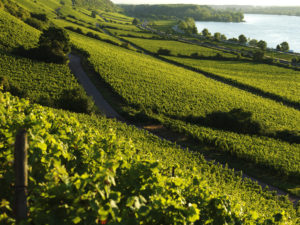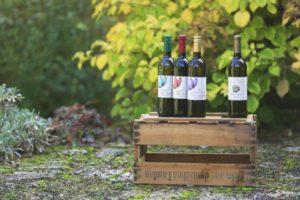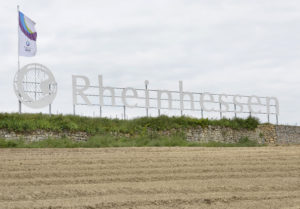Ever since the Romans planted the first vines in the climatically favorable region of Rheinhessen more than 2,000 years ago, grapes have been grown here. Now, increasingly frequent extreme weather conditions such as late frosts, hot spells, extreme drought and heavy rain are endangering the sensitive vines. What does future winegrowing look like?
Not all vines are the same

River valleys offer climatically favorable conditions for wine growing. Credit: Carsten Costard
Rheinhessen, with 27,000 hectares, provides a home for many different types of wine of various origins. The demands of the individual varieties are just as diverse as their origins. Accordingly, even small climatic changes can have a great impact on vine crops that have existed for centuries.
A permanent culture in transition
Due to climate change, the phenological phases are changing and expulsion in spring is earlier or later. Moreover, consequences of this are a change in flowering time, the start of maturity and leaf fall and an increased risk of late frost effects. Additionally, rising temperatures in the summer put the vine under stress, which changes the quality of the grapes and the character of the wines. What is already used in the warmer regions is also conceivable here in the future: An adaptation of the varieties as well as added irrigation will ensure yields and the preservation of the wine culture.
In addition, increased stress levels also mean increased susceptibility of plants to pests and diseases. Climatic changes, such as a prolonged precipitation period in spring, accommodate the development conditions of pathogens.
A vine revolution
In the future, the focus here will be probably on sustainability. Particularly fungus-resistant grape varieties – so-called PIWI wines – are not only especially robust, but also require fewer pesticides than conventional varieties, thus protecting the environment.

The pioneer bottles of the Wohlgemuth-Schnürr winery are characterized by their sustainable production and first-class taste at the same time. Credit: Winery Wohlgemuth-Schnürr
In this regard, the owners of the Wohlgemuth-Schnürr winery are true pioneers. Cabernet, Muscaris or Cabertin – these are among the names of the wines on which the winery will rely in the future. These new, robust grape varieties with a natural resistance to fungal attack grow on almost 60% of their vineyard area in the top vineyards of Rheinhessen, such as the Westhofener Morstein and the Gundersheimer Höllenbrand. For the realization of this vision, the winery tries to continuously inform itself about current developments in sustainable viticulture, to develop further and to invest consciously and thoughtfully.
Another example is Eva Vollmer Weine in Mainz. The Message of the wines is expressed in their names: “future wines”, consist of new grape varieties, crossed from a wild, powerful vine with high resistance and a cultivated vine for the full flavour. However, the team of winemakers not only wants to tackle this issue themselves, but also to sensitize other winemakers and wine connoisseurs to it. With the concept of “future wines” not only the wine but also the soil breathes a sigh of relief!
Linking nature conservation and wine
One measure for improving soil conditions that has been used in Rheinland-Pfalz for more than 120 years and which is gaining momentum in the context of climate change is “vineyard consolidation”. In addition to the primary goal of an even distribution of property, it has a positive effect on nature and contributes to better management.

The Rheinhessen sign in the Höllenbrand vineyards in Gundersheim is visible from far away. Credit: Uwe Feuerbach
The Gundersheimer Höllenbrand is an exemplary demonstration of the interplay between nature conservation and the economic interests of the winegrowing enterprises. The winegrowing area in the south of Rheinhessen, which today covers about 100 hectares, is the result of such a land consolidation process.
Dry stone walls stretch for around 10 kilometers along the cross-grazed southern slope, securing important habitats for animals such as the wheatear, the sand lizard and the little owl. At the same time, the merging of plots has improved the management of the vineyards. However, not only winegrowers and animals benefit from the preservation of the cultural landscape, but also tourism.
Learn more
Klimawandelinformationssystem Rheinland-Pfalz | Weinbau
Weingut Eva Vollmer – Zukunftsweine